Intel: For Mainstream Gamers, Our IGPs Are Equivalent to Discrete GPUs
by Anton Shilov on January 14, 2016 12:03 PM EST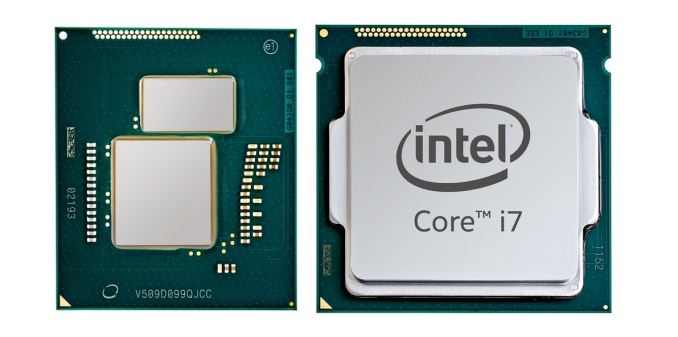
Intel’s integrated graphics processors (iGPUs) are the most widespread PC-class graphics adapters on the planet. Enthusiasts of high-performance personal computers do not use Intel’s iGPUs, but the world’s largest developer of microprocessors says that for mainstream and casual gamers its graphics solutions offer performance, which is comparable to that of inexpensive discrete video cards.
“For the mainstream and casual gamer, we have improved our Iris and Iris Pro graphics tremendously,” said Gregory Bryant, vice president and general manager of the desktop client platforms at Intel, at the J.P. Morgan Tech Forum at the 2016 International CES. “We have improved our graphics performance [by 30 times] from where it was five years ago. We believe that the performance of Intel’s integrated graphics today, what we offer in the products […], is equivalent to the performance of about 80% of discrete [GPU] installed base.”
Intel has been improving its integrated graphics cores at a rapid pace after the company cancelled its discrete graphics processing unit code-named Larrabee in 2010. Thanks to timely transition to newer process technologies, Intel could increase transistor budgets of its central processing units significantly every couple of years. As the company did not increase the number of general-purpose cores inside its mainstream CPUs for desktop and mobile personal computers in the recent years, the lion’s share of that additional transistor budget was spent on iGPU-related improvements.
Intel considers its code-named Clarkdale and Arrandale processors its first-generation CPUs with integrated graphics (which is not entirely correct since these CPUs had two dies: the processor die as well as graphics and integrated memory controller die). Back then, Intel’s most advanced iGPU featured 12 execution units (EU) with peak compute performance of around 43 GFLOPS. Since then, the architecture of Intel’s integrated graphics processors has evolved to accommodate new features and gain performance. Today, each EU features two ALUs that can execute up to four 32-bit floating point or integer operations per cycle (in fact, one of the two ALUs in Intel’s Gen8 EU also supports double precision 64-bit floating point operations). Intel’s latest microprocessors — Broadwell with GT3e and Skylake with GT4e graphics cores — have Iris Pro iGPUs with 48 and 72 EUs as well as peak compute performance of 883 and 1152 GFLOPS, respectively.
While Intel did not define what it considered to be the installed base of discrete graphics cards, it is obvious that the company compares its recent Iris and Iris Pro integrated graphics processors to discrete graphics adapters sold in the last five or even more years and which are currently in use.
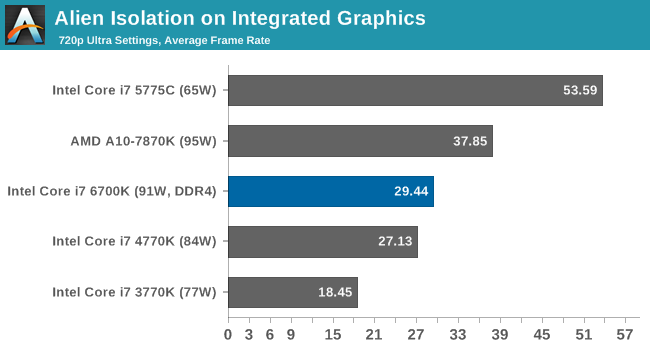
Intel’s latest integrated graphics processor found in its Skylake chips — the Iris Pro 580 with 72 execution units and 1152 GFLOPS compute performance — should outperform even more advanced discrete graphics processors. In fact, AMD's latest integrated graphics core also outperforms the low-end graphics card (albeit, by a small margin).
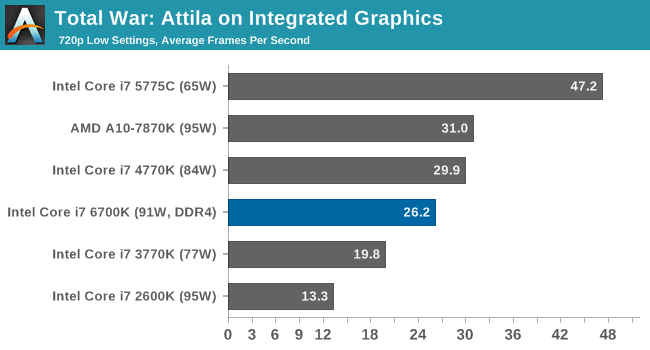

Because many people do not play demanding games that use the latest application programming interfaces (APIs), performance and features of Intel’s modern iGPUs may be enough for their needs. Moreover, since casual and even some mainstream gamers usually buy low-end graphics adapters, Intel’s Iris Pro 6200 and Iris Pro 580 can actually outperform such GPUs (or offer similar performance). It is not clear whether 80% of discrete graphics boards currently in use belong to the entry-level segment, but it evident that contemporary iGPUs are somewhat better than cheap video cards.
Even though enthusiast gamers do not use Intel’s high-end iGPUs, the company continues to thrive because of PC gaming. According to Intel’s management, sales of its Core i7-series microprocessors set records in Q2 2015 despite weak demand for personal computers overall. Moreover, Intel claims that shipments of high-end enthusiast-class hardware in general are at all-time high and growing. Intel sells not only powerful Core i7 CPUs with unlocked multiplier to demanding gamers, but also chipsets, solid-state drives, various controllers and other components for high-end PCs. As a result, the company takes advantage of increasing demand for powerful personal computers.
Source: Intel Investor Relations


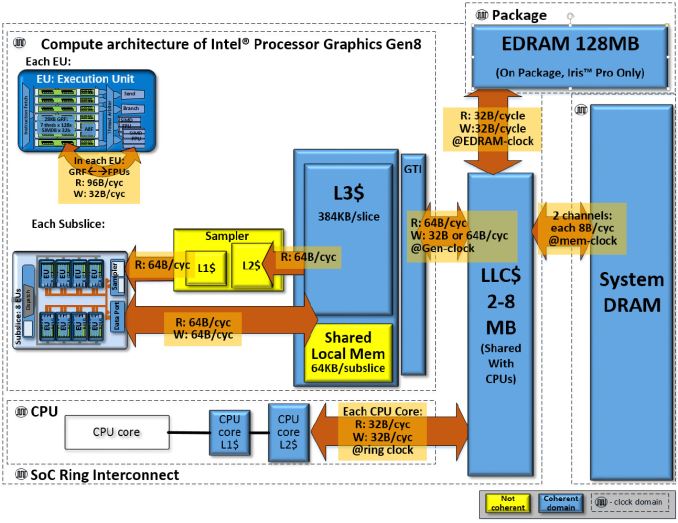
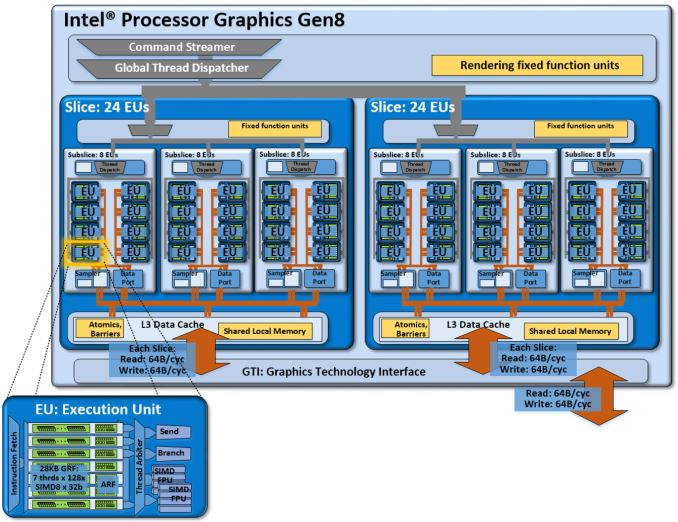








96 Comments
View All Comments
BurntMyBacon - Monday, January 18, 2016 - link
@jasonelmore: "Everything other resolution below 1080p is 1-2% or less"I'm going to assume you meant everything other than resolutions at or below 1080P. Steam survey says you are pretty close. 96.37% are at 1080P or below. Of course 1080P makes up 35.15% of their survey, so if you don't include 1080P, you only end up with 61.22%.
BurntMyBacon - Monday, January 18, 2016 - link
@ddriver: "I highly doubt people playing mine sweeper are the bulk of gamers out there. The mainstream gamer is the midrange gamer - and intel's hardware is really entry level."I would define the midrange gamer as the arithmetic mean. The mainstream gamer is probably best defined as the median where the casual gamer is probably the mode.
If you want to define it based on computer specs, given that more than half of the users on steam play on monitors less than or equal to 1600x900, I say that is probably a more realistic mainstream resolution.
BurntMyBacon - Monday, January 18, 2016 - link
@haukionkannel: "Mainstream are people who plays mine-sweep and solitaire with their computer."I'm pretty sure that falls into the casual gamer category.
Of course, mainstream isn't the arithmetic mean. The mainstream gamer is probably best defined as the median where the casual gamer is probably the mode.
Pure speculation (obviously mine) says that the mainstream group probably include people that play games like Minecraft, the SIMS, and perhaps Portal. There is a rather large MMO crowd and franchises like Call of Duty do push the median up given the number of followers, but the number of mine-sweeper and solitaire only gamers is far greater. That said, many who own a computer don't play games on it at all and some of the casual gaming crowd has migrated to their phones/tablets. As they drop off the list, the median edges upwards. In any case it is hard to say exactly where the median now lies and it is probably safe to say that it is a moving target.
zo9mm - Thursday, January 14, 2016 - link
Mainstream would not be considered "average". If we talk statistics, there's mean, median, and mode. Mean is the average. Mode, which is the number that occurs most often, would more accurately describe the "mainstream". If you look at all gamers, and over 50% of them play at 720P, while the remaining people play above that, 720P is the mainstream, while the average would be 1080P or over.BurntMyBacon - Monday, January 18, 2016 - link
@zo9mm: " Mode, which is the number that occurs most often, would more accurately describe the "mainstream""I tend to think of Mode as the casual gamer, though I'll accept that I'm not an authority. I also tend to look at it more from the type of games played than the hardware it is played on. From a hardware perspective, Mode may not be a good fit for any gamer set in this discussion.
In any case, if you define the mainstream as Median, the Median resolution is less than the 1080P ddriver suggested. If we accept steam surveys as representative, then 1600x900 is the median resolution. Interestingly, 1920x1080 is the Mode resolution in steam surveys with 35.15% followed by 1366x768 with 26.47%. Surprisingly, 720P only has 1.33%, and only 3.96% of gamers on steam's survey game at 720P or below. Perhaps steams survey isn't the most accurate, but it is easy to look up and statistically significant. Feel free to reference an alternate survey if you want to use it instead.
Thatguy97 - Thursday, January 14, 2016 - link
Hell ppl play cs go at 10 by 7 so they can see better. Not everyone cares about resolution.jragonsoul - Thursday, January 14, 2016 - link
Thank you! People act like to be mainstream you need a 1440p monitor with a high end GPU.BrokenCrayons - Friday, January 15, 2016 - link
I agree completely with you. Higher resolutions are nice, but I'm perfectly happy at 1024x768 or 1366x768 as it does a lot to remove the need to purchase a more powerful GPU and makes whatever GPU does end up performing graphics chores have an easier time of things. Plus, other visual effects can be turned up higher in exchange for the reduced resolution. It's an all around win to play at lower res which makes higher resolution a pretty unimportant thing. Sure it looks a little better, but there's a point of diminishing returns. For me, that point is rapidly reached above 1366x768.BurntMyBacon - Monday, January 18, 2016 - link
@BrokenCrayons: "Higher resolutions are nice, but I'm perfectly happy at 1024x768 or 1366x768 as it does a lot to remove the need to purchase a more powerful GPU and makes whatever GPU does end up performing graphics chores have an easier time of things."Thrilled to see you have enough sense to objectively evaluate your needs and set your requirements accordingly. My hat's off to you.
@BrokenCrayons: "Sure it looks a little better, but there's a point of diminishing returns. For me, that point is rapidly reached above 1366x768."
I think that depends on what games you play and how you play them. Taking shooters as an example, if you like to run and gun in a game with lots of tight corridors and not a lot of large open spaces, then there is no reason to up the resolution other than it looks nicer and 1024x768 is a nice cheap fit. If, however, you prefer to snipe at extreme range in games with large distances, then maybe resolution is extremely important to the point of giving up other visual effects and 4K makes some sense. Obviously monitor size plays a role here as well as if the monitor is too small, you eyes looks to ability to resolve such dense resolution seated 12 - 18 inches from the monitor. Most people fall somewhere in between these extremes. My games of choice and play style are such that 2560x1600 / 1440P is preferable, though I can perform well enough on 1920x1200 / 1080P. I also prefer 16x10 to the "Cinema oriented" 16x9 aspect ratio that is common place, but that is a topic for a different time.
mdriftmeyer - Thursday, January 14, 2016 - link
Mainstream/Casual gamers are on smartphones that run well past 1080p resolutions. They aren't playing on some entry level iSeries for < $900.